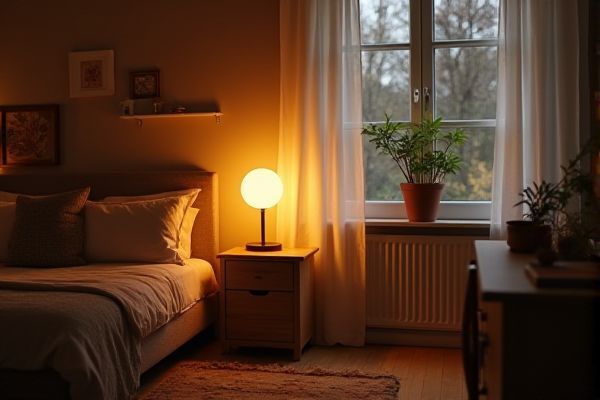
Dimmable lights offer adjustable brightness levels that allow you to create the perfect ambiance and save energy, while non-dimmable lights provide a fixed level of illumination suitable for consistent lighting needs. Discover how choosing between dimmable and non-dimmable lights can impact your space and energy usage by reading the rest of the article.
Table of Comparison
| Feature | Dimmable Light | Non-Dimmable Light |
|---|---|---|
| Functionality | Adjusts brightness levels | Fixed brightness |
| Energy Efficiency | Can reduce energy use by lowering brightness | Consistent energy use at full brightness |
| Compatibility | Requires compatible dimmer switches | Works with standard switches |
| Lifespan | Potentially longer due to reduced power | Standard lifespan |
| Cost | Higher upfront cost | Lower initial cost |
| Applications | Ideal for mood lighting, adjustable ambiance | Suitable for general, consistent lighting needs |
Understanding Dimmable and Non-Dimmable Lights
Dimmable lights offer adjustable brightness levels, allowing you to customize the lighting ambiance to suit different moods and activities, whereas non-dimmable lights operate at a fixed brightness. Using dimmable bulbs with incompatible fixtures or switches can cause flickering or damage, making it essential to match your lighting components correctly. Understanding the compatibility and functionality of dimmable versus non-dimmable lights ensures optimal performance and energy efficiency for your space.
Key Differences Between Dimmable and Non-Dimmable Bulbs
Dimmable light bulbs allow you to adjust brightness levels, providing greater control over ambiance and energy consumption, while non-dimmable bulbs operate at a fixed brightness. The key difference lies in compatibility; using a non-dimmable bulb in a dimmer switch can cause flickering, buzzing, or even damage to the bulb. Choosing dimmable options ensures your lighting system functions smoothly and extends the lifespan of your bulbs.
How Dimmable Lights Work
Dimmable lights function by adjusting the voltage or current flowing to the bulb, allowing you to control the brightness level smoothly. Unlike non-dimmable lights, which operate at full power constantly, dimmable lights use compatible dimmer switches that modify electrical signals to reduce light output without flickering. This technology enhances energy efficiency and extends the lifespan of your lighting fixtures by preventing unnecessary power consumption.
Advantages of Dimmable Lighting
Dimmable lighting offers enhanced control over brightness levels, allowing you to create customized ambiance and reduce energy consumption by using only the necessary light intensity. Unlike non-dimmable lights, dimmable options extend bulb lifespan by operating at lower power settings, resulting in long-term cost savings. This flexibility supports improved mood, productivity, and functionality in various environments, making dimmable lighting a superior choice for both residential and commercial spaces.
Drawbacks of Dimmable Lights
Dimmable lights can cause flickering, buzzing noises, and reduced lifespan if used with incompatible dimmer switches or fixtures. They typically require more expensive and complex hardware, increasing installation and maintenance costs compared to non-dimmable lights. Your lighting setup might face compatibility issues, limiting options for bulbs and dimmers that work seamlessly together.
Pros and Cons of Non-Dimmable Lights
Non-dimmable lights offer a cost-effective and straightforward lighting solution with consistent brightness and simpler installation, making them ideal for standard residential and commercial applications. However, they lack flexibility in light intensity adjustment, which can limit ambiance control and energy savings compared to dimmable options. Additionally, using dimmable fixtures with non-dimmable bulbs can cause flickering or damage, emphasizing the importance of compatibility in lighting design.
Choosing the Right Light for Your Space
Choosing the right light for your space depends on your desired ambiance and functionality. Dimmable lights offer customizable brightness, allowing you to adjust mood and save energy, while non-dimmable lights provide consistent, fixed illumination ideal for tasks requiring stable lighting. Assess your space's purpose and lighting needs to determine whether flexibility or reliability suits your environment best.
Compatibility with Switches and Fixtures
Dimmable lights require compatible dimmer switches designed to handle variable voltage levels, ensuring smooth brightness adjustment without flickering or damage. Non-dimmable lights typically work only with standard on/off switches and may experience reduced lifespan or flicker if used with dimmer switches. Proper matching between dimmable bulbs and dimmer-compatible fixtures is essential for optimal performance and energy efficiency.
Energy Efficiency and Cost Comparison
Dimmable lights offer superior energy efficiency by allowing you to adjust brightness levels, which reduces electricity consumption compared to non-dimmable lights that operate at full power consistently. Over time, using dimmable lights results in lower utility bills due to decreased wattage usage, whereas non-dimmable options can lead to higher energy costs without flexibility in light output. Initial costs for dimmable fixtures and compatible bulbs may be higher, but the energy savings and extended bulb lifespan often offset the upfront investment.
Frequently Asked Questions: Dimmable vs. Non-Dimmable Lights
Dimmable lights allow you to adjust brightness levels to create customized ambiance, while non-dimmable lights offer consistent, fixed illumination. Your choice impacts energy efficiency, bulb lifespan, and compatibility with dimmer switches, making it essential to select bulbs designed for dimming if you want variable light control. Understanding these differences helps you optimize lighting for functionality, mood, and cost-effectiveness in your space.
 homyna.com
homyna.com